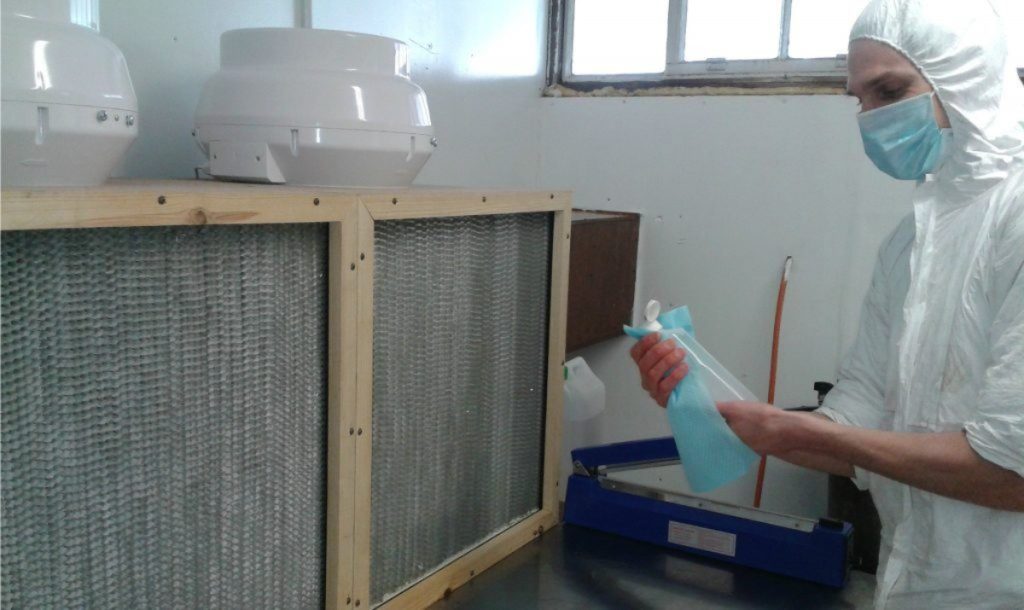Contamination is one of the biggest problems all mushroom cultivators face, whether small-scale home cultivators or large commercial enterprises.
Initially, you can grow hardy mushroom species using a glove box or clean room for inoculation, but if you hope to grow fussier species or scale your production, a laminar flow hood is recommended.
It will increase your chances of success.
Read on to learn how laminar flow hoods work, what you need to make one and how to design and build a DIY laminar flow hood.
What is a Laminar Flow Hood?
A Laminar Flow Hood is a specialized device designed to create a sterile workspace by blowing a constant stream of filtered air in one direction over a workspace.
For mushroom cultivators, a laminar flow hood provides a controlled space where the risk of introducing unwanted microorganisms is reduced, improving the chances of cultivation success.
Laminar flow hoods come in various shapes and sizes, but although designs may vary, they all contain the following core components:
- A filter
- A fan
- A box to hold the components
Smaller laminar flow hoods are portable, and you can use them to create sterile laboratory conditions in most spaces, including your spare room, garage or basement.
How Does a Laminar Flow Hood Work?
A laminar flow hood creates a consistent flow of clean air over a work surface, allowing cultivators to perform tasks like inoculation without introducing airborne contaminants.
It does this by blowing air through a High-Efficiency Particulate Air filter, also known as a HEPA filter, that captures contaminants like dust, spores and bacteria to create a smooth flow of contaminant-free air.
The filtered air moves in parallel lines vertically or horizontally across the work surface, pushing potential mushroom contaminants away and creating a sterile work environment.
What Filter is Needed for a Laminar Flow Hood?
You’ll need to use a specific type of HEPA filter for a laminar flow hood. Not just any HEPA filter.
The HEPA filter should be an H13 or H14-rated filter, as these remove more than 99.97% of particles at 0.3 microns (μm) in diameter.
Why is Constant, Smooth Airflow Important?
The smooth movement of air is crucial when creating a clean work environment, which is what “laminar” refers to.
The word laminar is used to describe a flow that follows steady streamlines without any turbulence.
Why is the absence of turbulence important? Turbulent air can swirl and reintroduce contaminated air back into our workspace.
A key element in achieving this smooth laminar airflow is the speed of the air. If the flow is too fast, it causes turbulence. Conversely, if it’s too slow, it also creates turbulence, reducing the sterile area downstream of the filter.
The ideal air velocity for a laminar flow hood should be 100 feet per minute or 0.5 meters per second.
The fan pushing air through the HEPA filter must be capable of maintaining this flow rate while accounting for the resistance created by the filter.
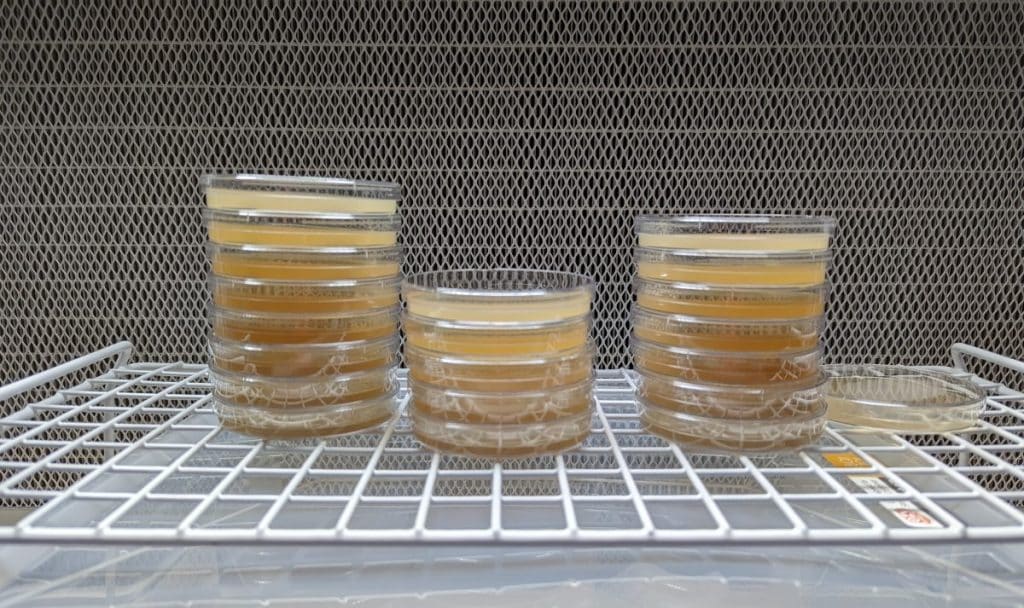
Different Types of Laminar Flow Hoods
There are a few different types of laminar flow hoods, with the main differences being:
- Horizontal vs. vertical airflow – Laminar flow hoods can be designed so the air blows horizontally from directly in front of the cultivator or vertically down from above the cultivator.
- Larger self-contained cabinets vs. freestanding units on a table – Laminar flow hoods may be enclosed within a larger cabinet unit or can be a freestanding unit positioned on a bench.
Sometimes, side and top edges are added to freestanding units to create more protection around the airflow, helping reduce air turbulence close to the filter.
You have a few options when choosing a suitable setup for mushroom cultivation. Ultimately, it boils down to your budget and what you prefer.
Many mushroom cultivators opt for freestanding horizontal airflow units when inoculating bulk substrate bags.
These setups are typically more affordable and provide a comfortable workspace for managing large bags, adding grain spawn, and moving them along a bench.
On the other hand, if you find a good deal on a used vertical flow hood inside a cabinet, it’s also a viable choice.
However, the space can be somewhat cramped when working with multiple substrate bags.
Some commercial operations utilize both types of systems. They may use a vertical cabinet when working with agar plates and liquid cultures. While reserving a horizontal unit for inoculating bulk substrates.
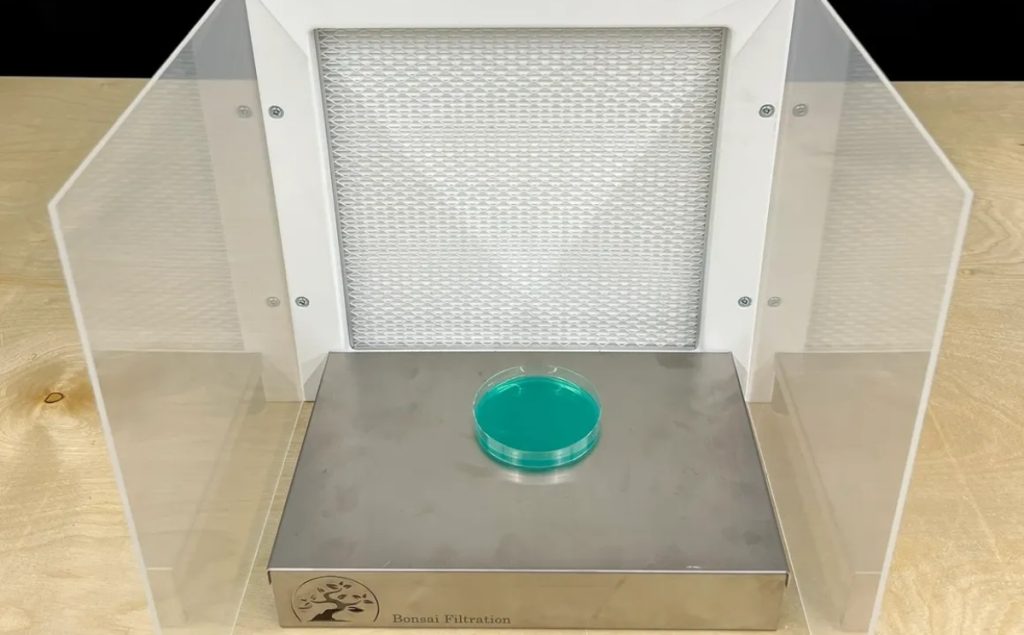
Building vs Buying a Laminar Flow Hood
Now that we’ve covered the different types of laminar flow hoods, let’s tackle the big question: should you buy a flow hood or build one yourself?
For most people, purchasing a ready-made unit is the better choice.
Numerous options are available, and the prices are similar whether you buy or build a laminar flow hood.
Most DIY designs require constructing a well-sealed wooden box to hold the HEPA filter. A fan is typically mounted on top of this to push air into a plenum space behind the filter and then through the filter.
If you’re not skilled in woodworking, you might need to hire a carpenter or furniture maker to assist you with making the box. The added labor and materials could easily exceed the price of a pre-made unit.
Even if you are handy with woodwork, building a laminar flow hood will still take hours that could be better spent on other aspects of your project.
However, if you require a larger flow hood for inoculating several bags at a time, a custom build is often necessary, as affordable off-the-shelf options are limited.
What Do You Need to Make a Laminar Flow Hood?
To make a laminar flow hood, you’re going to need the following items:
A HEPA Filter
Your HEPA filter should be rated at H13 or H14 and at least 3 inches (75mm) deep. This depth helps create a steady airflow.
While thinner and cheaper HEPA filters are available, they may allow more turbulence in the airflow due to their reduced thickness.
Adding a coarse pre-filter can be beneficial if you live in a windy and dusty area. This will capture dust and larger particles that could clog your HEPA filter over time.
Using a pre-filter can extend the life of your HEPA filter, and they’re usually incorporated into the box surrounding the fan, making them easy to change.
Keep in mind that the HEPA filter will create some resistance, which is important to consider when figuring out your fan needs. This resistance is known as static pressure.
Static pressure in a HEPA filter is generally measured in inches of water column (in. w.c.) or pascals (Pa) with a manometer.
Most HEPA filters exhibit static pressure ranging from 0.8″ to 1.0″. This measurement indicates how much friction the air encounters while passing through the filter.
The pre-filter will also add a bit of static pressure, typically between 0.1″ and 0.2″, bringing the total static pressure for the system to around 1.0″ to 1.2″.
This amount of static pressure is significant and requires a properly sized fan to ensure a steady flow of clean air in your space.
Manufacturers usually provide details about the efficiency and static pressure of their filters.
A Fan
There are two main types of fans used in laminar flow hoods:
- In-line centrifugal fans -These are made for general ventilation and industrial settings where lots of clean air is needed at low to moderate pressures.
- Squirrel cage centrifugal fans – These feature a unique impeller design that resembles the exercise wheel found in pet cages, giving them their name. Also called forward-curved blower fans, they are built for high-volume, low-pressure tasks.
Squirrel cage fans are most often used by mushroom cultivators for laminar flow hoods because they maintain a strong airflow even under higher static pressure.
However, if you find an in-line centrifugal fan that meets your required static pressure, these can also work. They tend to be quieter and more energy-efficient.
The size of your fan should match the dimensions of your HEPA filter and the static pressure levels. Once you’ve picked your filter, you’ll have the necessary details to determine the correct fan size.
Fans are measured by the air volume they can move at zero static pressure, typically expressed in cubic feet per minute (CFM). As static pressure increases, the airflow produced by the fan decreases.
Manufacturers usually provide a “performance curve” that shows how much air a specific fan can produce at different static pressures.
You don’t want an overly powerful fan, but having more airflow is better than having too little. As the filter collects dust, its resistance will increase, so a slightly stronger fan can be beneficial.
A Case or Box
The box’s role is to house the fan and filter and contain the airflow from the fan so that the only exit is through the filter, creating a laminar flow of clean air on the other side.
The box needs a plenum, or air-filled space, behind the filter between the fan and the filter. This allows the air to be distributed evenly, creating even, steady airflow through the entire HEPA filter.
If the fan was positioned right up against the filter, you would get a strong flow in the area where the fan is and less around the edges.
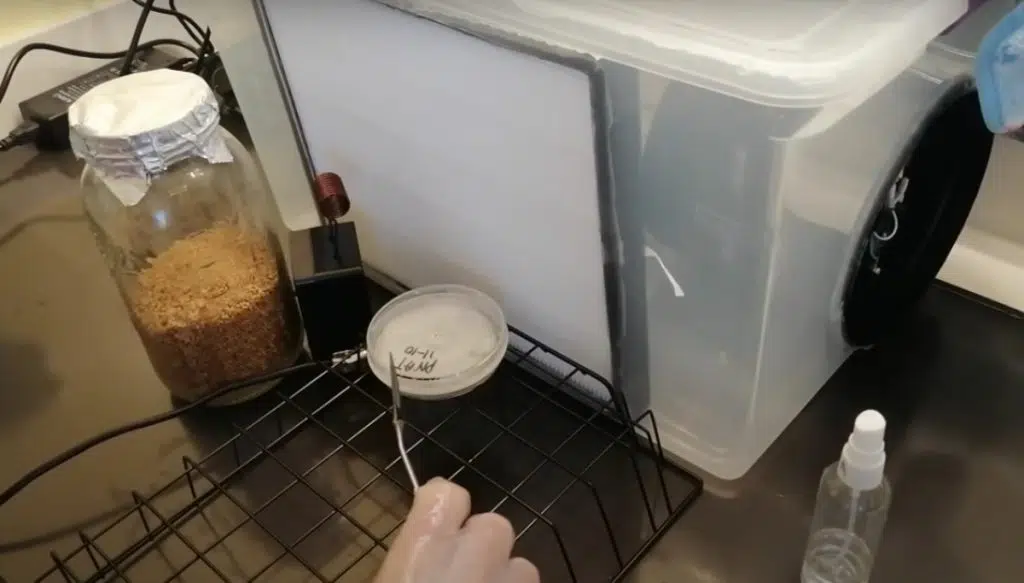
Factors to Consider When Designing a Laminar Flow Hood
There are several factors to consider when designing your laminar flow hood, including:
Filter Size
When deciding what size filter to use, consider the scale of your mushroom production and your budget.
However, a laminar flow hood 2ft x 2ft (61 x 61cm) is the smallest size you should consider for inoculating substrate bags.
A flow hood of this size works well for smaller-scale production, but you’ll be limited in terms of how many bags you can have open in the sterile airflow simultaneously.
When you start to scale your batch sizes, it will slow you down as you have to stop to rotate sealed bags out and bring in new bags ready to inoculate.
Many growers start with a 2ft x 2ft (61 x 61cm) filter and then add another one, creating 4ft x 2ft (122 x 61cm) of sterile airflow.
We recommend you get the largest HEPA filter you can afford.
Fan Strength
When selecting a fan, you’ll need to note the filter’s surface area and static pressure and the fan’s performance curve, showing how much airflow it produces at a given resistance.
What size fan for a laminar flow hood?
Once you have your filter, you can calculate what size Laminar flow hood fan is required.
First, take the velocity of airflow that you need, which is 100ft/minute (0.5m/s), and multiply this by the surface area of your filter.
This gives you the total volume of airflow that the fan needs to deliver, but you’ll also need to account for the static pressure of the filter and find a fan capable of producing the required airflow at this static pressure.
For example, a 2ft x 2ft filter will have an area of 4 sq ft.
You would then multiply this by 100ft/minute, the required volumetric flow rate of clean air for mycological work.
4 sq ft x 100 ft/ min = 400 cubic ft/min or 400 CFM.
Thus, you’ll need to find a fan that can provide 400 CFM of air at the 1.0″ of static pressure of the HEPA filter and pre-filter combined.
Most manufacturers will have a fan curve that shows the air velocity that the fan will produce at different static pressures and you can use this to ensure your select a suitable model.
Location
The location of your mushroom lab, or more specifically, the quality of the air going into your fan, will dictate whether you’ll need a pre-filter or not.
However, most growers recommend installing a pre-filter at the blower fan’s intake regardless of the amount of dust and other particles in the air, as they prevent big particles from clogging up the HEPA filter and are cheaper and easier to replace.
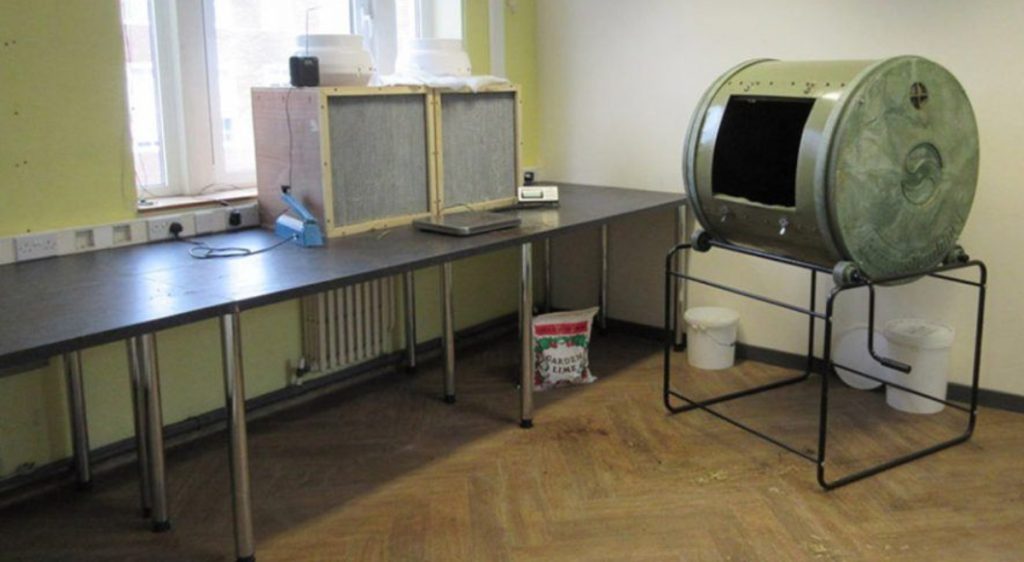
How to Build a Laminar Flow Hood Step-by-Step
The steps below will take you through the process of making a larger wooden box-style laminar flow hood, as this is what most mushroom growers need to inoculate bags of substrate.
You can also make a smaller DIY plastic tote laminar flow hood, but these are better suited for culture work, agar plates, liquid cultures, etc., than multiple bags of substrate.
This project is better suited to people with some woodworking experience and the necessary tools to cut and join the pieces of wood.
Alternatively, you’ll need to find someone with these skills and tools to help you contract the box for your flow hood.
Follow the steps below to build a DIY laminar flow hood.
Step 1: Gather the Equipment You’ll Need
The first step when building a laminar flow hood is to buy all the equipment and materials that you’ll need, including:
- A HEPA filter
- A centrifugal fan
- A pre-filter (Optional but recommended)
- Materials to construct a wooden box – Most designs use plywood or MDF wood sheets
- Screws
- Silicon sealant
Step 2: Build the Box to House the Filter and Fan
The idea is to build a box around the HEPA filter that creates a space for the fan to blow into, called a plenum.
The front wall of the box will be the HEPA filter, and one of the other sides or the top will have a hole for the fan’s inlet.
Plywood or MDF, at least 5/8″ (15 mm) thick, is good to use for the box as it’s strong enough to withstand any vibrations caused by the fan.
Begin by attaching the filter to the front of the base, then install the sides and back.
You’ll need to seal all joins with silicon to ensure the box is airtight and air only flows out the filter.
Step 3: Install the Fan
First, cut a hole in the piece of wood for the top of the box, the correct size for the fan’s inlet or outlet.
The fan can sit on top of the box or inside the box underneath the hole you have made, and once it’s inserted, the join also needs to be sealed with silicon.
Some people build an extra box on top with an external pre-filter, but you can also tape the pre-filter directly onto the fan’s inlet.
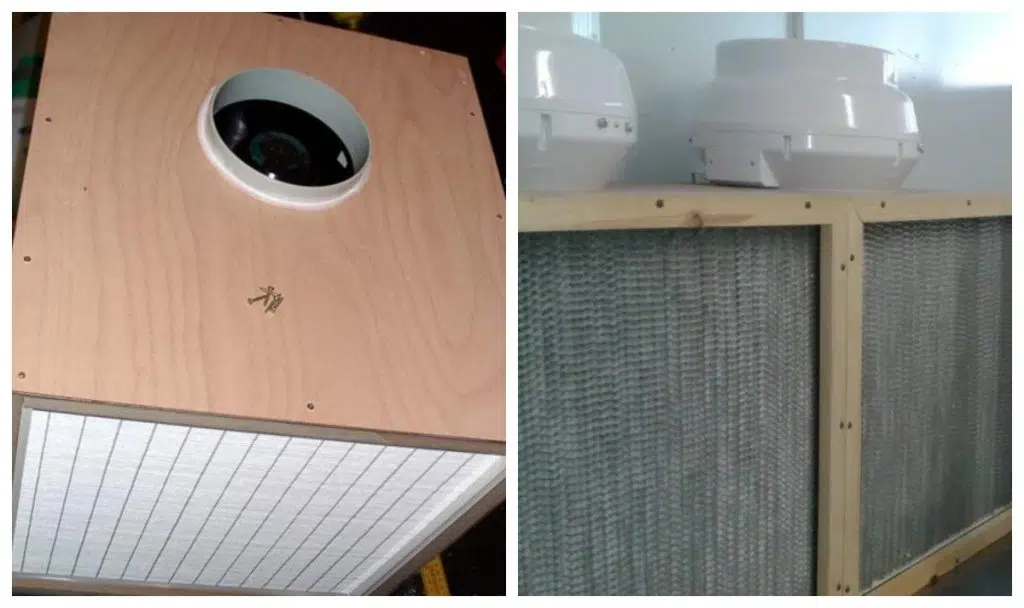
Step 4: Test Your Laminar Flow Hood
Once you’ve completed your laminar flow hood, it’s time to test it.
A popular way to test, without expensive equipment, is to hold a lighter in front of the filter’s face and move it around to check for even airflow.
Ideally, you should have a steady flame at a 45-degree angle in all areas.
If the flame’s angled at 90 degrees or gets blown out, it’s a sign the airflow is too strong, and you need to turn down the fan.
But if the flame remains straight up or has less than a 45-degree angle, the fan is not providing the required air velocity.
You can also use an anemometer to measure airflow speed or buy an airborne particle counter to measure how many particles of a given size are in the air stream.
Laminar Flow Hood Care and Maintenance
Your HEPA filter should last many years, as most are made for 3000 to 5000 hours of use.
Your pre-filter will extend the HEPA filter’s life and should be changed at least once a year. You may need to change it more often if you live in a dusty environment.
Ideally, you should have a cover or panel that you can place in front of the HEPA filter to protect the metal fins and paper pleats from accidental damage while not in use.
Final Thoughts
When you first begin your mushroom-growing journey, a laminar flow hood is unnecessary, especially if you grow mushrooms the low-tech way.
We suggest beginners start with hardy, fast-growing mushroom species, like oyster mushrooms, that don’t need sterile inoculation conditions or sterilized substrates.
However, once you have experience, you may want to start a small-scale mushroom-growing business and try other species.
At this point, a laminar flow hood is recommended, as it will significantly reduce the chances of contamination and ensure consistent yields.
Want to learn how to grow mushrooms? Try one of our comprehensive mushroom cultivation courses.
